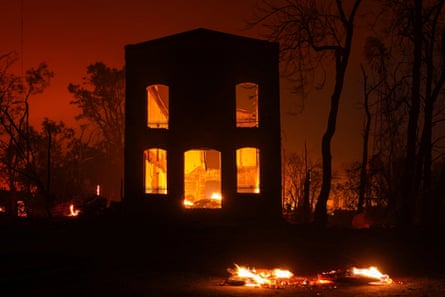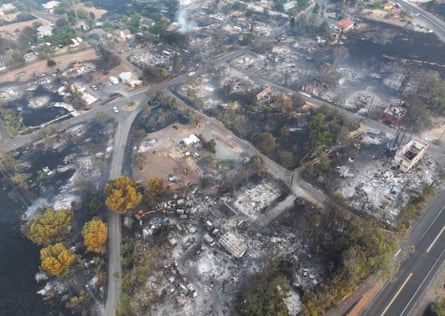Multiple structures have burned in a historic Gold Rush town in northern California after thousands of lightning strikes ignited a spate of fast-moving fires in the rural dry foothills of the eastern Sierra.
Chinese Camp, about 57 miles (92km) east of Stockton and named for the Chinese miners who settled there, is a registered California landmark filled with historic structures, and home to roughly 60 residents.
Officials have not yet released details on the scale of the damage, but footage from the fire line showed buildings leveled and engulfed in flames, as firefighters battled through the night.
It was not yet clear whether the town’s handful of Gold Rush-era structures – including an old post office built in 1854 – had been damaged. A shuttered Catholic church dating back to 1855 appeared to have survived the flames. The town’s general store where tourists could pick up supplies and see historic artefacts also seemed to be intact. But on some lots, all that remained were charred brick walls and scorched trees.
The complex of lightning-sparked conflagrations broke out on Tuesday. By Thursday morning, the so-called TCU September Lightning Complex had spread across more than 13,700 acres, with 15% containment. The wildfire was on of more than a dozen conflagrations burning across the state.

“You can see the scale of destruction from this fire,” the local news KCRA reporter Peyton Headlee said in a social media video as she walked down the main road of Chinese Camp, now laden with smoldering rubble on all sides. The blaze had already jumped Highway 120 and Highway 49, she said.
“When a historic building burns, it’s a piece of history we lose,” Stephen Provost, who wrote the book Chinese Camp: The Haunting History of California’s Forgotten Boomtown, told the San Francisco Chronicle. “When a whole town like that goes – I mean, wow … I just can’t. It’s just devastating.”
California’s governor, Gavin Newsom, secured a grant from the Federal Emergency Management Agency (Fema) to support fire-suppression efforts, his office announced on Tuesday, and pre-deployed firefighting resources to five counties across the northern part of the state facing elevated risks.
“We are securing all available resources – including support from our federal partners – to fight this growing lightning complex fire in Calaveras and Tuolumne counties,” Newsom said in a statement.

Along with the eight blazes that are considered part of the TCU September Lightning Complex, dozens of other fires are burning in the state, with months left before the high-risk conditions begin to subside.
The fires are spread across the region about 120 miles east of San Francisco. There have been no reports of injuries, but several structures were destroyed in two of the fires, said Emily Kilgore, a spokesperson for the California department of forestry and fire protection (Cal Fire), the state’s chief fire agency. Damage assessments have not been completed.
Many of the fires are in remote and rugged areas, some with very difficult access, Kilgore said.
“There still may be fires that haven’t been discovered yet,” Kilgore said, warning that more evacuations may be necessary.
Temperatures were expected to be in the 90s during the next few days with little rain in sight. Strong winds added to the challenge as flames strengthened in areas filled with dry, tall grass and brush, according to Cal Fire.
The largest of the fires crossed 10 sq miles (26 sq km) around Chinese Camp, where at least five homes burned. During the first hours, residents moved tree branches and shoveled sand on to flames in a desperate attempt to stop them from spreading until firefighters arrived. A recreational vehicle on a property was damaged.
Chinese Camp, now a pass-through for tourists traveling to Yosemite, flourished in the 1850s as a stagecoach stop and supply hub for mining camps during the Gold Rush.

Thousands of Chinese immigrants came to California during the Gold Rush and faced persecution that included an exorbitant foreign miners tax designed to drive them away from mining.
The town grew as Chinese miners who were driven out of a nearby camp arrived, according to Visit Tuolumne County. Originally called Camp Washington, its name was soon changed to reflect the thousands of people from China who settled there.
It has already been a devastating year of fire in California, starting with the firestorm that swept into communities across Los Angeles in January, killing 31 people. Overall, there have been more than 6,500 wildfires in the state in 2025, collectively burning close to half a million acres.
Significant fire potential is forecast to be above normal in September across northern California, according to an analysis from the Interagency Fire Center issued on Monday, and high risks are likely to linger into October.
The Associated Press contributed reporting

 2 days ago
2 days ago


















